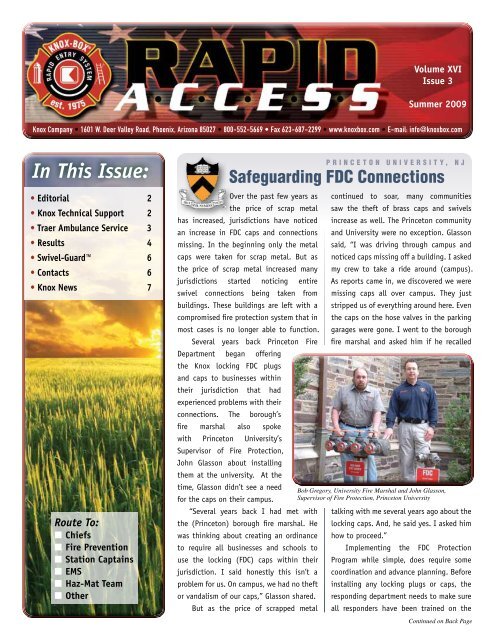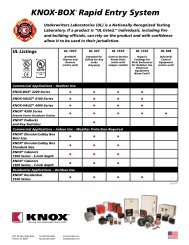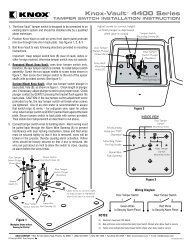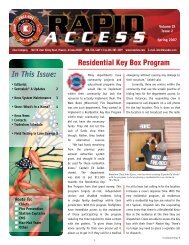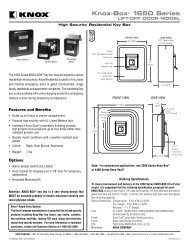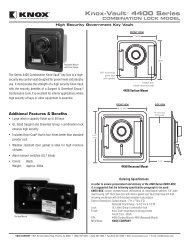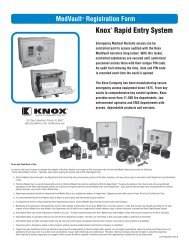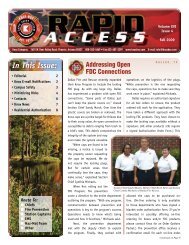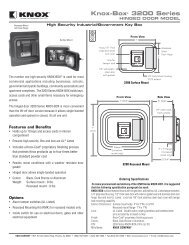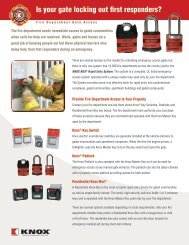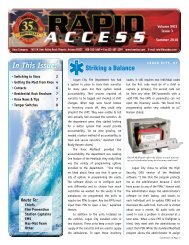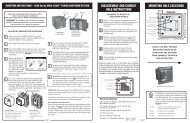In This Issue: - Knox Box
In This Issue: - Knox Box
In This Issue: - Knox Box
Create successful ePaper yourself
Turn your PDF publications into a flip-book with our unique Google optimized e-Paper software.
Volume XVI<strong>Issue</strong> 3Summer 2009<strong>Knox</strong> Company • 1601 W. Deer Valley Road, Phoenix, Arizona 85027 • 800-552-5669 • Fax 623-687-2299 • www.knoxbox.com • E-mail: info@knoxbox.com<strong>In</strong> <strong>This</strong> <strong>Issue</strong>:• Editorial 2• <strong>Knox</strong> Technical Support 2• Traer Ambulance Service 3• Results 4• Swivel-Guard 6• Contacts 6• <strong>Knox</strong> News 7Route To:■ Chiefs■ Fire Prevention■ Station Captains■ EMS■ Haz-Mat Team■ OtherOver the past few years asthe price of scrap metalhas increased, jurisdictions have noticedan increase in FDC caps and connectionsmissing. <strong>In</strong> the beginning only the metalcaps were taken for scrap metal. But asthe price of scrap metal increased manyjurisdictions started noticing entireswivel connections being taken frombuildings. These buildings are left with acompromised fire protection system that inmost cases is no longer able to function.Several years back Princeton FireDepartment began offeringthe <strong>Knox</strong> locking FDC plugsand caps to businesses withintheir jurisdiction that hadexperienced problems with theirconnections. The borough’sfire marshal also spokeSafeguarding FDC Connectionswith Princeton University’sSupervisor of Fire Protection,John Glasson about installingP R I N C E T O N U N I V E R S I T Y , N Jcontinued to soar, many communitiessaw the theft of brass caps and swivelsincrease as well. The Princeton communityand University were no exception. Glassonsaid, “I was driving through campus andnoticed caps missing off a building. I askedmy crew to take a ride around (campus).As reports came in, we discovered we weremissing caps all over campus. They juststripped us of everything around here. Eventhe caps on the hose valves in the parkinggarages were gone. I went to the boroughfire marshal and asked him if he recalledthem at the university. At thetime, Glasson didn’t see a need Bob Gregory, University Fire Marshal and John Glasson,for the caps on their campus. Supervisor of Fire Protection, Princeton University“Several years back I had met with talking with me several years ago about thethe (Princeton) borough fire marshal. He locking caps. And, he said yes. I asked himwas thinking about creating an ordinance how to proceed.”to require all businesses and schools to Implementing the FDC Protectionuse the locking (FDC) caps within their Program while simple, does require somejurisdiction. I said honestly this isn’t a coordination and advance planning. Beforeproblem for us. On campus, we had no theft installing any locking plugs or caps, theor vandalism of our caps,” Glasson shared. responding department needs to make sureBut as the price of scrapped metal all responders have been trained on theContinued on Back Page
E d i t o r i a lWe hope you find the articles thismonth informative. We have twodepartments with unique applicationsas well as an article on getting results.If you haven’t checked out what is newat <strong>Knox</strong>, I’d suggest you stop by ourbooth at an upcoming tradeshow inyour area. Since many of you may notbe able to travel to the national showsdue to the economic downturn, we havemade a company decision to continueto exhibit at many of the state andregional shows. So, even if you can’ttravel to one of the national shows, youshould still be able to see <strong>Knox</strong> at alocal show. On page 7, you will find ashort listing of some of the upcomingshows where we will be exhibiting.The <strong>Knox</strong> newsletter is the firedepartment’s voice as well as ours. If youwould like to share how your departmenthas solved issues by instituting the<strong>Knox</strong> program, or if you have somevaluable pointers for departmentsjust implementing the system, let’sspread the word in the newsletter.Please contact me at 800.552.5669ext 505 or cjones@knoxbox.com.Thank you for your support of the <strong>Knox</strong>System. We look forward to servingyour department for years to come.<strong>Knox</strong> Technical Support1-866-566-9269When a department purchases a <strong>Knox</strong> electronic product or software, the purchaseprice includes technical support from <strong>Knox</strong>. While some manufacturers chargecustomers for technical support, <strong>Knox</strong> does not.<strong>Knox</strong> has an entire department devoted to technical support. If you’re havingan issue with an electronic product or software, please contact tech support at thenumber above if you’re unable to resolve the issue yourself within 5-10 minutes.We can usually save you time, energy and effort.When you call in, the technician will ask some basic information to locate youraccount. They will record the call and any details in your account’s history. (It’s alsoa good idea to record the name of the individual you spoke with for your records.)<strong>This</strong> information will help us better serve you, if you have to call back. We ask thatyou provide as much information as possible on the issue. The more informationyou’re able to provide, the quicker we’ll be able to help you resolve the issue.Our technicians are trained to provide service on our units and software. <strong>In</strong>most cases, they’re able to resolve the problem in one call. If they are unable toresolve an issue after two attempts, they will forward the issue on to an engineerto review. Once the engineer reviews all the notes on the account, they will contactthe department to gather further information and troubleshoot the problem. <strong>In</strong> thevast majority of cases, an engineer can solve the issue over the phone.<strong>In</strong> rare cases, the issue cannot be resolved over the phone. <strong>In</strong> these cases, youwill be asked to either return the unit to the factory or an engineer may be sent tothe department. The course of action taken is based on several criteria includingthe nature of the issue and the number of units impacted. If an engineer is sent tothe department, we ask that the department provide an individual familiar with theissue to accompany the engineer during their visit as they will need information onthe issue as well as access to the units.Occasionally, the issue is actually a request to modify a product or its software.While we review all requests received, we are not always able to fulfillthem. Some changes require re-engineering of the product or software.All re-engineering projects go through a process that can take from six monthsto more than a year depending on the complexity of the change. Finally, we willnot make a modification if we determine that it would weaken the integrity of theproduct’s security.If you do have an issue, do not hesitate to give technical support a call. They’rehere to help you with your technical questions at no charge to your department.EditorCynthia JonesPublisher<strong>Knox</strong> CompanyArt DirectorCynthia WeissAll products mentioned in this document are registeredtrademarks and copyrighted by their respectiveowners.Rapid Access is published bimonthly by <strong>Knox</strong>Company, 1601 W. Deer Valley Road, Phoenix, AZ85027. ©2009 <strong>Knox</strong> Company. All Rights Reserved.2
Traer Ambulance ServiceT R A E R , I A<strong>In</strong> 2005, Traer AmbulanceService in Traer, Iowawas looking for a wayto improve access andcare to residents within their jurisdiction.“People would leave their key with usor tell us the key was at such and suchlocation such as the ceramic frog by thefront door,” stated Martin Herker. All keysgiven to the department were kept at thestation. When responding to a residence,the crew had to remember to take theresident’s key with them. “If we forgot totake the key with us, it was of no goodto us,” Herker said. Hiding an entrancekey on site holds many drawbacks. Whileresponders can find the key, so cananyone else looking to find a way inside.Additionally, “during the winter thatceramic frog would be covered with 1-2feet of snow and ice. We’d have to digjust to find the frog,” Herker explained.“We began asking ourselves whatcould we do to improve access and care?We talked with several neighboringdepartments to get some ideas and settledon the <strong>Knox</strong> System,” Herker shared. TraerAmbulance felt the biggest selling pointfor deciding to go with the <strong>Knox</strong> Systemwas the security of the system. Sincethe boxes are going on residences, manyhomeowners were concerned about othersMartin Herker of Traer Ambulance Service drillingto mount a residential <strong>Knox</strong>-<strong>Box</strong> on a home.being able to get inside the <strong>Knox</strong>-<strong>Box</strong> togain access to their homes. “We showed asample box at community events. The boxcan’t be pried open. A key is needed.” Whenthe department received their KeySecureunit, they took it to a few communityevents and challenged residents to getthe key out of the unit. “They were unableto remove the key without a PIN code,”Herker said.Originally, Traer began their <strong>Knox</strong>Program to help provide care for thoseresidents using the Lifeline® service.Next, they expanded the programto several senior housing apartmentcomplexes. More recently, they have addeda box to the entrance of a fitness centerthat provides after hours access to somemembers via a swipe card. These membersgenerally are in the center by themselves.If they fall off the treadmill or twist theirankle working out, they can call TraerAmbulance to provide medical assistance.They carry an emergency call button thatcontacts Traer Ambulance directly. TraerAmbulance is able to enter the facility byusing the <strong>Knox</strong>-<strong>Box</strong>.Traer Ambulance provides the <strong>Knox</strong>Program to their community as a freeservice. They received funding for the first20 boxes and two KeySecure units via agrant from a community foundation. Thegrant provided funds to pay for 50% of theinitial purchase. The department providedthe remaining funds. As funds have becomeavailable, they have purchased additionalboxes. Today there are approximately 40residential boxes installed within theircommunity. All boxes are owned bythe department and are lent out to theresidents. Residents do not purchase theirown boxes.The department installs all boxesand when a box is no longer needed ata residence, Traer Ambulance removesthe box. <strong>In</strong>stalling and removing a boxprovides a great opportunity for theresponders to meet with those in thecommunity in a non-emergency setting. Itis very common for a neighbor to inquireabout an ambulance in front of a home.<strong>This</strong> allows the department to explain the<strong>Knox</strong> Program and answer any questionsresidents may have.Located in east central Iowa, TraerAmbulance is a combination career/volunteer EMS provider covering 140square miles in northern Tama County.They maintain two ambulances with athree person crew on call at all times.3
ResultsThe scene repeats thousandsof times each day.A person needs Fire or EMS assistance and someone dials911. According to U.S. Fire Administration statistics, the totalof all calls (Fire, EMS, Mutual Aid, Haz-mat, and Public Service)equals 25 million each year. That means that at any point intime there are literally thousands of fire and rescue personnelresponding to alarms, not to mention policeand city support services. <strong>In</strong> virtually everycase, the first responders show up promptlyand mitigate the situation. Hour after hour,day in and day out, no matter the situation,from a minor overheated fluorescent lightballast, to a multiple alarm high rise fire withtrapped victims, the nearly 75,000 Engineand Truck companies and 50,000 EMS units inAmerica answer the call.<strong>In</strong> today’s society, people want results. When it comes totheir government and the services it provides, they demand it.They expect the trash truck to come by on the same day everyweek and they expect to see emergency crews at the frontdoor within a few short minutes after they call 911. People aretypically more demanding of governmental agencies than theyare their commercial counterparts because as taxpayers theyare paying the bills. People are used to efficiency in the privatesector and want comparable performancefrom public organizations. People wanttheir government responsive, reliableand consistent. <strong>In</strong> most cases, they getwhat they want. Despite the stereotypicalviews that are usually associatedwith government employees and thebureaucracy, most times, the system worksseamlessly. Turn on the faucet and watercomes out, flip the switch and the lightscome on, call 911 and first respondersshow up promptly. <strong>This</strong> does not happenwithout practice and a willingness tomake changes along the way. Fire recruitspractice donning bunkers and air packsuntil it becomes second nature. Engineand Truck Companies practice drill fieldevolutions on a regular basis. Preventionofficers take great care to do functionaltests to ensure that sprinkler and alarmsystems work properly. The model fireand building code organizations are ina constant state of refinement. Eachyear these code experts meet to make,usually minor, but sometimes major codechanges to make buildings safer and moresustainable. It is not about reinventingthe government every few years. It is morean attitude of continual improvement bylocal governments, where strategies andprograms are continually evaluated toensure the best result. The key to tacklingthese large issues is to focus in on onemanageable problem, solve it then moveto the next one. <strong>This</strong> is what an ongoingcontinuous performance improvementor a ‘best practices’ approach looks like.<strong>In</strong> many instances problems will appearless complex using this approach. For apublic safety organization it means a totalcommitment to providing the highest levelof service while implementing the besttools available to accomplish the task.4
y Larry PiggSmall Steps toEnhance SafetyTake a look at your community. Lookfor vulnerabilities and security risks. Hereare some suggestions that are easy toimplement:• Promote Prevention and PublicEducation. Promoting prevention andeducation not only lessens the negativeeffects of fires, it can also provide asafer working environment for firstresponders.• Pass a local ordinance or amend thefire code to require that all buildingscome up to the same performance level.• Apply for a fire prevention grant.These grants, administered by FEMA,have proven to be a positive and costeffective way to enhance your fireprevention efforts, including retrofitprograms.• Examine the fire sprinklerand standpipe connections in yourcommunity. Are the protective FDC capsmissing? The <strong>Knox</strong> FDC program is aneffective way to protect water-basedfire protection systems.• Do you havehigh-rise buildingswith passengercar elevators?A <strong>Knox</strong>-<strong>Box</strong> mounted near the elevatorcorridor that houses the emergencyoverride key is an effective, secure wayto allow emergency crews to bypass therecall function, get to the desired floor,evacuate the occupants, and attackthe fire.Residential <strong>Knox</strong>-<strong>Box</strong> ®with door hanger• Do perimeter• Develop a residential <strong>Knox</strong>gates that canprogram geared toward seniors andcreate barrierspeople with limited mobility. A <strong>Knox</strong>to fast emergency residential box will allow for promptresponseresponse by EMS and fire crews withoutsurround apartment forcible entry, and will be reassuring tocomplexessenior citizens that live alone.or commercial• Establish a protocol forbuildings?periodically inspecting and servicing the<strong>Knox</strong>-<strong>Box</strong> key boxes in your community.The installation of a <strong>Knox</strong> Key Switch or<strong>This</strong> will enhance consistency of<strong>Knox</strong> padlock can help lower responseoperation and will help ensure that thetimes and enhance the security.most current access key is in the box.• <strong>In</strong>stall a <strong>Knox</strong> Cabinet near highprofile target hazards. These couldinclude Haz-mat facilities, airports,schools, or any other occupancy thatoffers unique challenges for emergencyA proactive prevention effort hasalways been important to the total serviceyou provide your citizens. <strong>In</strong> light ofchanging trends and emerging threats, itresponders. Require that MSDS, is now vital: it is also important that youresponse plans, contact and resourcelists be housed in the cabinet.look for areas of vulnerability and makechanges as they become evident. <strong>Knox</strong> isalways ready to help.We are totallycommitted to Fireand EMS. Pleasecontact your local<strong>Knox</strong> ® FDC Plugwith Swivel-Guard<strong>Knox</strong> representativefor assistance.5
Congratulationsto our FDICWeathervane Winner!Jeff PollardFreedomVolunteer Fire DeptFreedom, WIFREELiteratureAs a reminder, colorful brochuresexplaining the benefits of the<strong>Knox</strong> Rapid Entry System areavailable to your department fordistribution to property owners.<strong>This</strong> literature is available at nocharge to all departments. ContactFire Department Support or logon to www.knoxbox.com and clickon support/request literature.KNOX NEWS2009 Tradeshow ScheduleShow Location DatesMO Fire Marshals Conference August 3 Osage, MONC State Firemans August 20-22 Raleigh, NCFire Rescue <strong>In</strong>ternational August 25-29 Dallas, TXMontana Fire Chiefs September 18-20 Helena, MTCanadian Fire Chief September 20-23 Winnipeg, MBAlaska Fire Chiefs September 21-26 Anchorage, AKCITA - Kirkwood September 26-27 Cedar Rapids, IACA Fire Chiefs September 28-30 Riverside, CAMN Fire Chiefs October 15-18 Duluth, MNVital Signs October 15-18 Rochester, NYIllinois Fire Chiefs October 19-20 Peoria, ILHawkeye Fire <strong>In</strong>spectors October 20-23 Ankeny, IAEMS Expo October 26-30 Atlanta, GAFL Fire Prevention Conference November 2-5 Maitland, FLWisconsin Fire <strong>In</strong>spectors November 3-7 Eau Claire, WIAssociation of Fire Districts NY November 5-7 Ellenville, NYHawaii Fire Chiefs November 19-21 Waikoloa, HIThe Key to a Secure System<strong>Knox</strong> System security is always important. Protecting the <strong>Knox</strong> ® Master Key anddocuments listing installation addresses helps ensure that the <strong>Knox</strong> System is solely forthe benefit of your department.The four security steps listed below are the ways your department contributes to thesecurity of the <strong>Knox</strong> program in your community. Thank you for following these simple yetimportant rules.1. Keep all <strong>Knox</strong> keys in a secure place.2. Do not release the <strong>Knox</strong> provided keys to any non fire departmentor law enforcement personnel.3. Do not provide <strong>Knox</strong> installation database access to any non fire departmentor law enforcement personnel unless required by law.4. Notify <strong>Knox</strong> immediately of loss, theft or attempted duplication of any key.1601 W. Deer Valley RoadPhoenix, Arizona 85027623-687-2300800-552-5669623-687-2299 Faxwww.knoxbox.com7
1601 W. Deer Valley RoadPhoenix, AZ 85027PRESORTSTANDARDU.S. POSTAGEPAIDPHOENIX, AZPERMIT NO. 1662MADE IN THE USA© Copyright The <strong>Knox</strong> Company 2009.Safeguarding...Continued from Front Pageprogram and that those responding havea key wrench to unlock the connections.Also, if any neighboring departmentsupplies mutual aid, they also need keywrenches for their apparatus. (<strong>Knox</strong>provides key wrenches to the departmentat no charge).“My biggest concern about adoptingthe program was the key (wrench) butthat didn’t become a problem,” sharedUniversity Fire Marshal Bob Gregory. “Themost important thing is to make sure thefire apparatus have the key to open thelocking caps.” When the University decidedto implement the program on campus, theborough’s responding apparatus alreadyhad keys since several businesses withinthe borough had caps installed. “Workingwith the fire department and <strong>Knox</strong>, theUniversity’s fire staff was supplied keywrenches,” stated Glasson.After determining that everythingwas set with the fire department, theUniversity’s fire staff was ready to moveforward. For most fire departments,funding for the FDC program isn’t a hurdle.P R I N C E T O N U N I V E R S I T Y , N JThe cost of the plugs and caps is paid by The borough fire department comes tothe building owner. <strong>In</strong> this instance, the the campus frequently throughout the yearbuilding owner was Princeton University to train. While some of their visits focusand they had numerous buildings to outfit. on becoming familiar with the campus and“I went to our administration and said, building locations, others involve training‘<strong>This</strong> is going to be an ongoing problem drills. “We’ve had a few standpipe drillswith theft.’ I told them I was going to on campus where we actually hooked upneed X amount of dollars to start this and pumped water into the system in aprogram, and I told them I know it’s a parking garage. <strong>This</strong> gives fire personnelchunk of change. But the University the opportunity to get used to using theis very proactive when it comes to life system and opening the connections withsafety. We can’t afford to have the fire the key. I’ll tell you it wasn’t a problem.department arrive at a dormitory and have I was surprised. I generally find thingsa defective fire department connection, so that are easy to get off can be difficultthe University administration gave us the to get back on, but they went back onfunds to purchase and install the product,” just as easily. No one has come backshared Glasson.saying they’ve had difficulty using them,”Princeton University was very explained Glasson.proactive in addressing this issue. They “I have a better level of confidenceinstalled locking FDC plugs and the with these (locked connections) that theySecureCap on all connections on campus won’t be stolen and we won’t have peopleover a 2 month period. “We used a camera for whatever reason disrupting the systemfor every fire department connection and at all. So if they need to be used, I’mchecked all the piping to make sure there confident no one has been able to get towas absolutely no debris, and then we them and disrupt them – that’s a plus,”installed them on every fire department shared Gregory.connection, every hose valve that is ina parking garage and on fire departmentpump test headers.”


